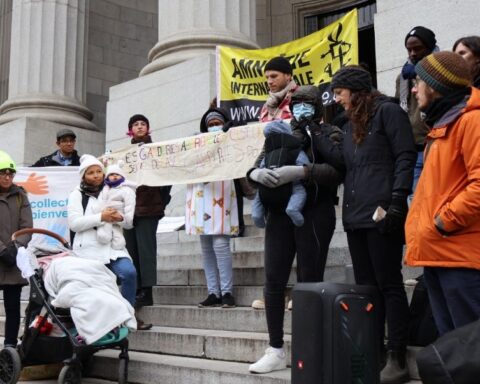When I visited a Ugandan Asian family in Calgary recently, I was amazed to notice a huge picture of Idi Amin prominently displayed in their living room.
“Isn’t this the same Idi Amin who expelled all brown-skinned citizens from the country?” I asked.
“Yes, it is,” my host responded. “We have placed his picture as a gesture of gratitude for expelling us as otherwise we would have never left Uganda. We were stupidly loyal to the country, invested to the fullest and considered it our home, but Amin opened our eyes. Thanks to him, we are now settled in Canada, the United States and Europe.”
The story begins on August 4, 1972, when Amin, who had declared himself president of the East African country in 1971 after a coup, proclaimed that he had had a dream in which God instructed him to expel the country’s Asians. Amin blamed the Asians for hoarding wealth and goods to the detriment of indigenous Africans, “sabotaging” the Ugandan economy.
At the time, most of the Asians living in Uganda were born in Uganda and many had taken out Ugandan citizenship when the country became independent from the United Kingdom in 1962. Asian businessmen and industrialists had invested heavily in the country, believing and trusting the African government in power.
But that trust was shattered when Amin’s dream became a nightmare for as many as 60,000 Asians, who became stateless, and destitute as families were limited in what they could take with them. It was the largest Asian exodus in African history.
This year, Ugandan refugees celebrate 50 years since Amin forced them to leave, creating a diverse diaspora in many parts of the world. One of Amin’s victims was Alnoor Manji (not his real name*) of Calgary whose family had shared their last supper in Kampala, having packed to leave for Canada the next day, when they were awakened during the night by a gang of robbers, who robbed them of their belongings, jewellery, and cash in exchange for their lives. They left behind their thriving businesses – a wholesale grocery store and a used car dealership.
Another victim, Azim Teja, (not his real name*) had to leave his multi-million-dollar family businesses, comprising a coffee factory, a sugar plantation, a trucking company, a stone quarry, and an ice-cream factory. Ironically, when Amin was announcing his edict, Teja was holding the opening ceremony for his ice-cream factory.
Both Manji and Teja have thrived in Canada.
A prominent Ugandan refugee family is the Nanji family who never forgot Canada’s humanitarian gesture of providing a home for them and pledged to pay Canada back when they had the means to do so. Their legacy of philanthropy is remarkable as they have donated millions of dollars to causes that are close to their hearts, including paying for a state-of-the-art magnetic resonance imaging machine (MRI) for Sunnybrook Hospital in Toronto.
Giving back to community
“Giving back to a community that has given so much to us is just the right thing to do,” Pyarali Nanji said at the time of the donation.
Another prominent family driven from Uganda is the Laljis who went on to establish themselves as one of the preeminent property owners in British Columbia’s Lower Mainland. In 2017 their holdings included Whistler Village Centre, Maple Leaf Self Storage, Maple Leaf Property Management, Park Royal Mall in West Vancouver and luxury hotels like the Fairmont Chateau Laurier in Ottawa. Based in Vancouver, the Laljis’ Larco Group of Companies had an estimated net worth of $3 billion in 2017.
Amin fled Uganda in 1979. In 1986, Uganda’s president, Yoweri Museveni, invited the expelled Asians to return to the country in an effort to improve the economy, promising to return their confiscated properties. A few of them did return, forgiving and forgetting the mistreatment they received in 1972. Today, Uganda’s richest men have Asian names like Madhvani, Hirji and Ruparelia. They contribute more to tax money than the combined populations of entire districts.
Fifty years later, the penniless Asians who had to flee Uganda, are grateful that Amin chose to follow his dream. That sad chapter in their lives has ended and a new segment, more promising and favourable, has begun in their adopted countries. The silver lining of the whole episode has been that the children of these refugees have benefitted by taking advantage of the available educational opportunities. The first generation of ex-Ugandan Asians has turned out a number of successful professionals such as doctors, lawyers, teachers and journalists.
The story of Ugandan refugees is a successful story of assimilation into Canadian society, worthy to be emulated by other migrants. The Ugandan refugees have done well for themselves, thanks to the positive and welcoming environment created by the country. They now have a bright future and contribute to Canadian society, one we can all be proud of.
___________________________________________
*Name withheld, please see NCM’s policy on anonymous sources.
Mansoor Ladha is a Calgary-based journalist, travel writer/photographer and author of Memoirs of a Muhindi: Fleeing East Africa for the West and Portrait in Pluralism: Aga Khan’s Shia Ismaili Muslims. Mansoor has held senior editorial positions with newspapers in Canada, Kenya and Tanzania. For many years, he was the only newspaper owner of colour publishing mainstream newspapers in Morinville and Red Water in Alberta.




